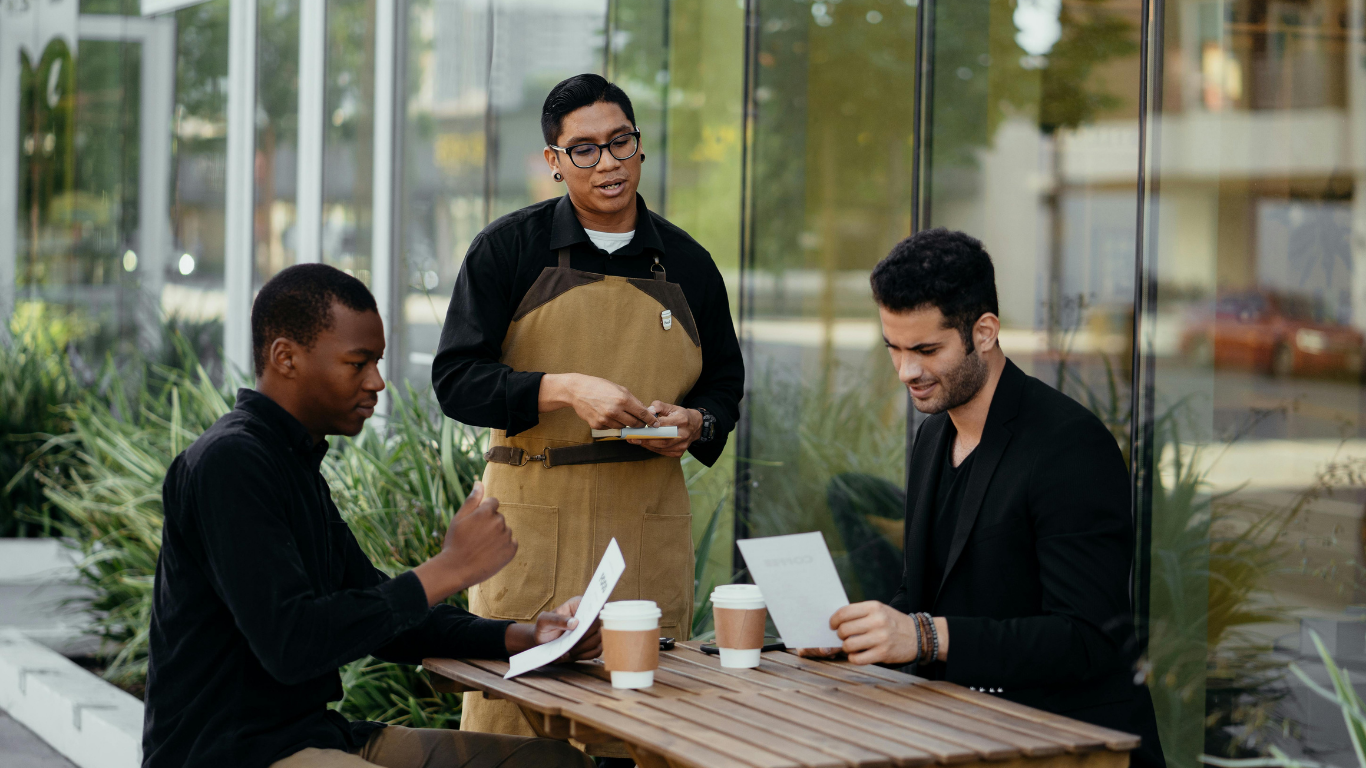
Ordering Food and Drinks
Master the art of ordering food and drinks at a restaurant. Our beginner-friendly dialogues and phrases will help you confidently talk to a server and get exactly what you want to eat and drink.
BEGINNER
Vocabulary
order
To ask for food or drink in a restaurant.
- I'm ready to order now.
- He wants to order pizza.
- What do you want to order for your drink?
beverage
A drink.
- I'll have a soft beverage with my meal.
- The menu has many beverage options.
- Hot beverages are on the next page.
Grammar Tip: Using 'I want...' vs. 'I would like...'
'I want...' is direct and simple, great for beginners. 'I would like...' or 'I'd like...' is slightly more polite and is a good phrase to learn early on. Both are perfectly fine for ordering.
Common Mistakes
❌ Saying 'I need a cheeseburger' instead of 'I want a cheeseburger.'
✅ Use 'I want...' or 'I'd like...' to state your choice. 'Need' is for when something is essential and can sound demanding.
While a waiter will understand 'I need...', it's not the most natural or polite way to order. Using 'I want' or 'I'd like' is the correct and common way to express your wish.
❌ Forgetting to say 'please' and 'thank you.'
✅ Always add 'please' when you make a request and 'thank you' when you receive something.
These are basic words of politeness that are very important in English-speaking cultures. They show respect and make the interaction more pleasant.
Notes for Learners
- Be ready with your food choice and drink choice.
- Listen for the waiter's questions, like 'Anything else?'
- Confirm your order when the waiter repeats it. Say 'Yes, that's right.'
- Stay calm and speak clearly. It's okay to ask the waiter to repeat something if you don't understand.
INTERMEDIATE
Vocabulary
grilled
Cooked on a grill over fire or heat.
- I ordered a grilled chicken sandwich.
- The grilled vegetables were very tasty.
- Do you prefer grilled or fried fish?
side
A small portion of food served with the main dish.
- The steak comes with a side of potatoes.
- Can I get a side salad instead of fries?
- The waiter forgot our side of vegetables.
Grammar Tip: Using 'I'll have' and 'I'd like'
'I'll have' is short for 'I will have,' and it's a very common way to order. It's a confident and natural-sounding choice. 'I'd like' (short for 'I would like') is a bit more formal but is also perfect for ordering.
Common Mistakes
❌ Saying 'I want to go with...' instead of 'I'll go with...'
✅ The phrase 'I'll go with...' is a very natural and common way to state your choice at a restaurant. It sounds more like a decision than a simple desire.
'I'll go with...' is short for 'I think I will go with...' It's a very conversational and humanized way to order and is a key phrase for intermediate learners.
❌ Not using 'please' or 'thank you' with every request.
✅ Even for small requests like 'a glass of iced tea,' it's polite to add 'please.' And always thank the waiter for their help.
Politeness is a constant. Using 'please' and 'thank you' consistently shows good manners and makes the interaction smoother.
Notes for Learners
- Be ready to order your drinks and food at the same time.
- Listen for follow-up questions from the waiter, like 'Anything else?' or 'Is that all?'
- Use phrases like 'I'll have...' or 'I think I'll go with...' to make your choice.
- Remember to order sides or extra items at the same time as your main dish.
ADVANCED
Vocabulary
appetizer
A small dish eaten before the main course.
- Let's share an appetizer before we order our main dishes.
- The appetizers on this menu are amazing.
- What is your favorite appetizer?
substitution
The action of replacing one thing with another.
- I'd like to ask for a substitution on this dish.
- The recipe allows for a substitution of ingredients.
- Can I make a substitution for the vegetables?
Grammar Tip: Using modal verbs for advanced requests
Modal verbs like 'could' and 'would' are essential for advanced politeness. 'Could I get it with...' is a very common and polite way to ask for a change to a dish. 'Would you like to...?' is a polite way to offer something to someone.
Common Mistakes
❌ Simply stating what you want without the extra polite phrases.
✅ Advanced English is about more than just words. Use phrases like 'I'd like to ask for a substitution' to be more polite and professional.
In advanced conversation, the way you phrase your requests matters. Using longer, more descriptive phrases shows a higher level of language mastery and social awareness.
❌ Not specifying the cooking preference for your meat.
✅ When ordering steak or other meat, it's a good practice to state how you want it cooked (e.g., rare, medium, well-done).
This is a key part of ordering in many restaurants. Specifying your preference upfront ensures you get the dish exactly as you want it, preventing a mistake later.
Notes for Learners
- Be ready to order appetizers, main courses, and drinks all in one go.
- Use specific details for your order, like 'medium-rare' or 'gluten-free.'
- Listen for phrases like 'dining companion' (a formal term for the person you are eating with) and 'sincere apologies.'
- Don't be afraid to ask for something that isn't on the menu, like a substitution, but do so politely and be prepared for the answer to be 'no.'